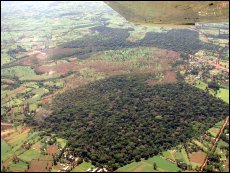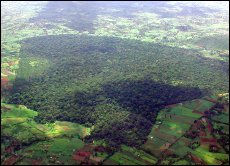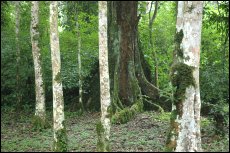|
The second phase of BIOTA East Africa focused mainly on the collection of baseline data, the development of rapid assessment methods and capacity building. The scope was extended to the over-all aim "sustainable use of biodiversity", meaning the long-term sustainability of rain forest systems in East Africa. The modified approach aims at warranting a maximum maintenance of biodiversity and its function as well as promoting the compatible use of biological diversity with profit for the local population. Major aims for this integrated approach are defined as follows:
- Analysis of changes of biodiversity and ecosystem function along gradients of degradation
- Analysis of changes of economic use of habitats along these gradients
- Identification of an optimum relation between maintaining a high level of biodiversity and a tolerable economic profit from forest use: identification of the point of sustainability
- Innovations for sustainable use of biodiversity and biodiversity management; development of recommendations and information policy according to the aim of fair benefit-sharing^
Socio-economic research was significantly extended and closely linked to studies on biodiversity function. It is assumed that the outcome of both research activities will provide a figure of different gradient-dependent levels of interference. The determination of an optimum relation between maintaining biodiversity function and contemporary economic utilisation will be an important key component. Besides others, the integrated approach of BIOTA East Africa addresses the following scientific questions:
- What is the status of functionality of important ecosystematic interfaces in forests and replacement communities?
- What are the benefits and costs of maintaining and utilising biodiversity?
- How are forests influenced by land use practices?
- How do agricultural systems depend on biodiversity?
- Are there alternatives to current practices with respect to sustainability?
- What are the measures to sustain the local communities' economic profit?
Compilation of the results achieved will lead to the development of management scenarios and a subsequent implementation of instruments to contribute to the aim of sustainable use of biodiversity. All activities will be characterised by the involvement of local communities, stakeholders, management authorities and policy makers. By support of the necessary human and technical network through significant capacity building, BIOTA East Africa gives the required incentives to conserve and use biodiversity according to the sustainable CBD approach.
Kakamega Forest in Western Kenya will remain the main study site. Its habitat mosaic is perfectly suited to investigate the aspects mentioned above along a gradient of degradation and fragmentation, especially when socio-economic studies are concerned. In addition Kakamega Forest offers the ideal opportunity to evaluate the effect of different forest management regimes and provides an ideal model case. The only restriction constitutes the lack of undisturbed primary forest. Therefore, a comparable area with undisturbed forest (Budongo Forest, Uganda) has been included as a reference site and as a testing area for developed assessment methods.
The standardised methodology used by BIOTA East Africa illuminates all important hierarchical levels of biological diversity, namely diversity at the genetic, population, species, guild, community and ecosystem levels. Data on the abundance, population growth and fluctuations, distribution and dispersal of certain keystone species as well as indices for richness and composition of communities are obtained. Forest regeneration forms another major topic, including key factors like average and range of tree ages, diversity of foliage profiles, canopy density and size, cycling rates for various key nutrients and intensity/frequency of disturbance events. Field activities of different subprojects are located mainly in sites defined as biodiversity observatories. Experiments and observations are carried out as close to each other as possible without risking mutual interference. Socio-economic assessment, compilation and synthesis of existing natural resources, prevailing forest utilisation and land use practices require an analysis of stakeholder interests and interactions. GIS technology is used to connect all these aspects and to bring results to the landscape level. Activities are strictly co-ordinated within the BIOTA East Africa network, warranting the interchange and joint processing of comparable data. Integration into the general BIOTA research approach is achieved by drafting research concepts according to well-defined overarching themes.
Apart from the continuation of already established co-operations and capacity building measures at East African counterpart institutions (e.g. NMK, KWS, KEEP, University of Nairobi, Makerere University, University of Maseno, WAC, ICIPE, etc.), particular efforts are undertaken to enhance personnel capacity building in two different ways - summer schools and support through the KAAD. Scheduled summer schools will include interdisciplinary training and field courses for students and para-ecologists, some being attended by Africans and Germans. Another type of course will provide advanced training for staff members of relevant research institutions and forest management organisations. The number of African Ph.D. and MSc. students educated is significantly increased by a BIOTA East Africa-specific scholarship programme of the KAAD.
Tasks for the third phase of BIOTA East Africa include the implementation of developed instruments to manage the sustainable use of biodiversity as well as the transformation of results achieved in model studies to a more generalised approach for rain forest systems. An integrative information policy at local, national and international levels is required to process complex feedback information and to give the desired input at all levels of decision-making. The third funding phase is focused on strategic cross-cutting themes and on the completion of a large number of deliverables. The exit strategy includes among others completion of infrastructure needed by counterparts, production of manuals, field guides, recommendations especially for participatory forest management and land use planning, and essential measures for capacity building.
|

Kenia
Kakamega Forest-Malava
© Dr. Rainer Steinbrecher

Kenia
Kakamega Forest-Buyangu
© Dr. Wolfram Freund

Kenia
Kakamega Forest-Kisere
© Dr. Rainer Steinbrecher

Uganda
Budongo Forest
© Dr. Thomas Gerken

Uganda
Mabira Forest
© Dr. Thomas Gerken
|






 Go to the WeatherNet
Go to the WeatherNet



